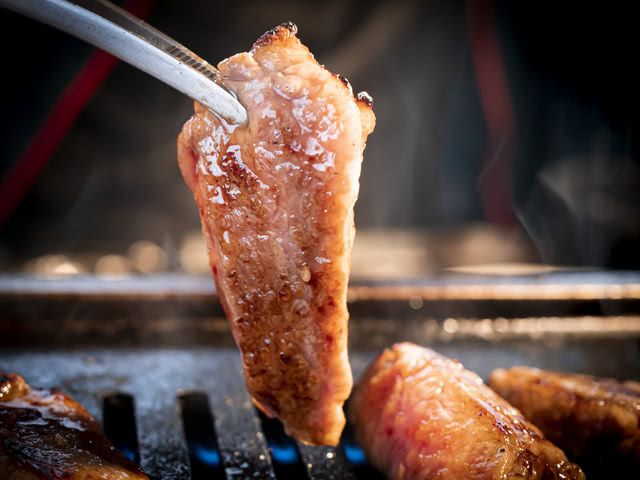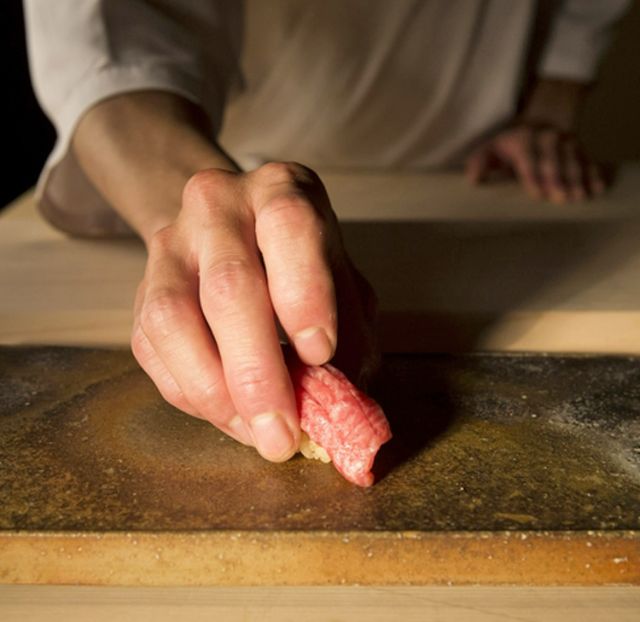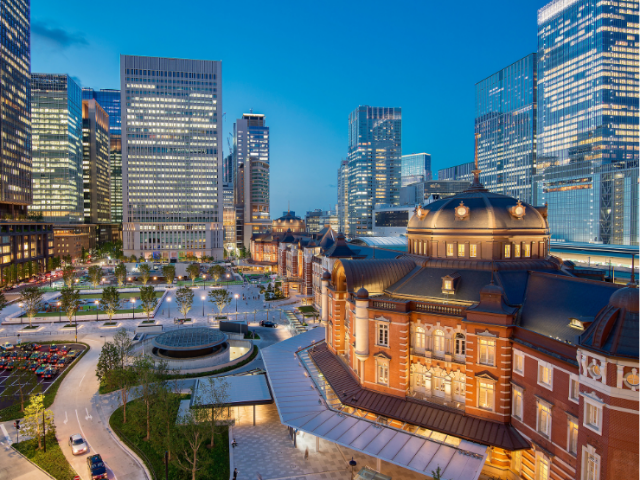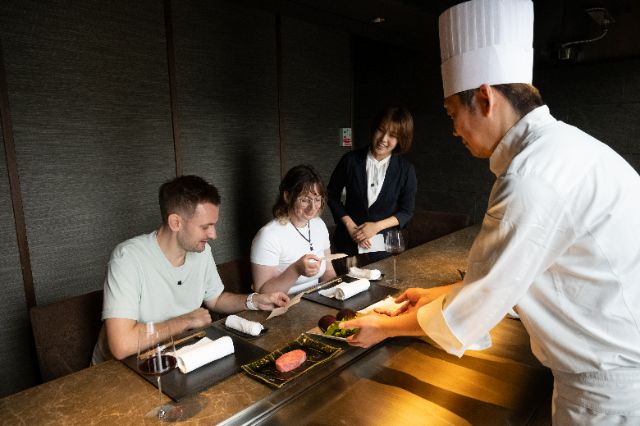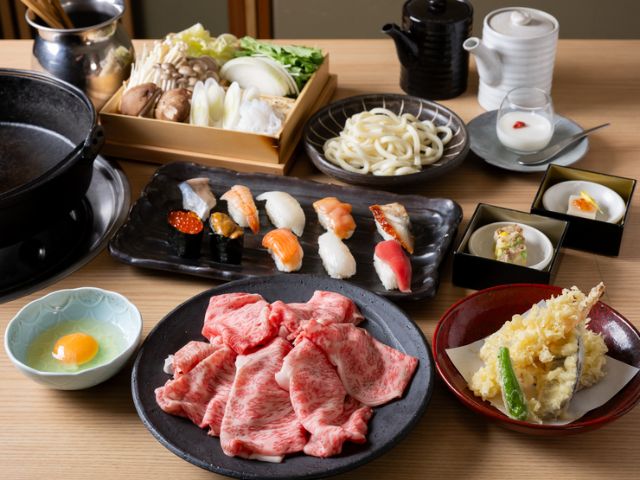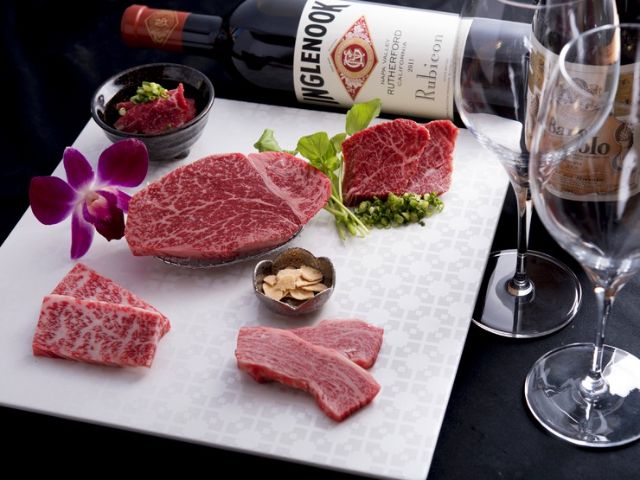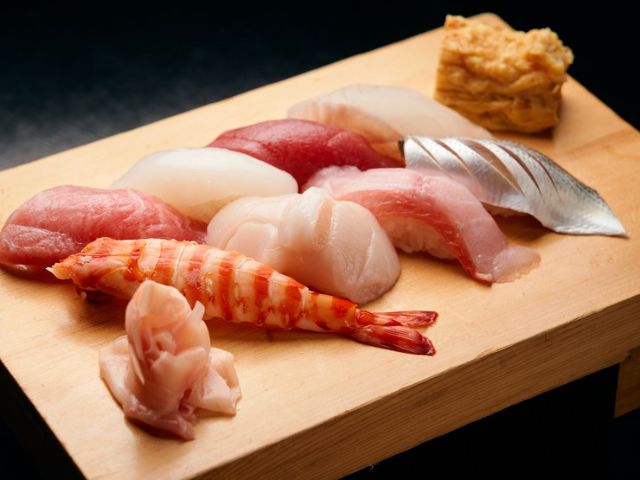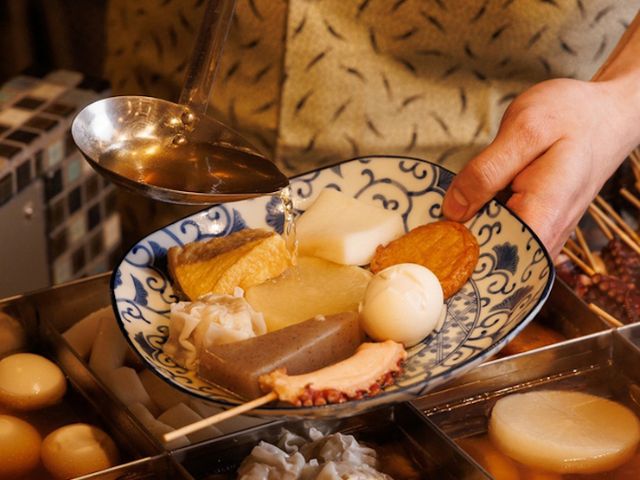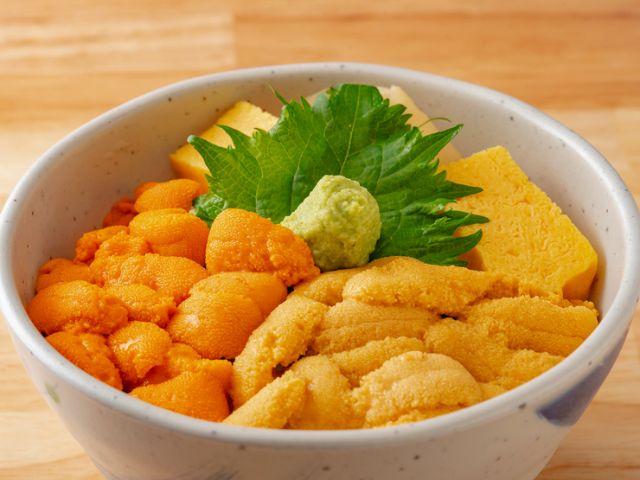Glorious Autumnal Spectacle! Tokyo's Ginkgo-Lined Streets Awash in Golden Splendor!
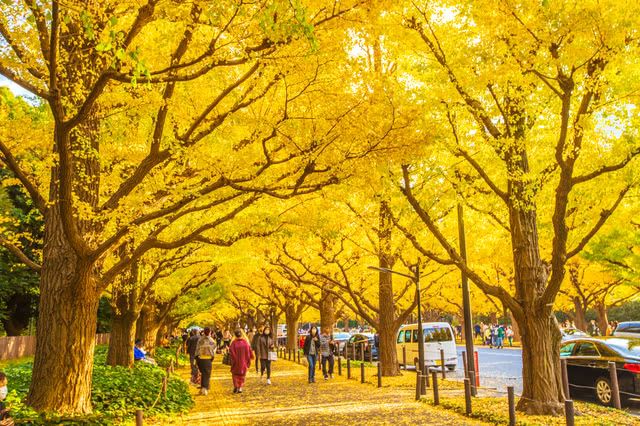
'Tis the Season for Gingko––Indulge in Japan's Autumnal Allure

Ginkgo trees can reach heights of around 30 meters with trunk diameters of about 2 meters, and these mighty giants bear numerous fan-shaped leaves. The optimal window to view Tokyo's ginkgo leaves in their golden glory usually spans from mid-November to early December. This is when every leaf from top to bottom turns brilliant golden hues to create a truly magnificent spectacle! But the magic doesn't end there. As the leaves fall from trees, they form a golden carpet on the ground, adding another element of wonder to the seasonal experience. These majestic ginkgo trees are usually planted along the roadsides, so you should be able to come across this awe-inspiring scenery during your strolls through Tokyo.

As the ginkgo leaves make their magical transformations, the peak season sweeps across the nation from south to north, much like the progression of cherry blossoms. However, unlike the brief ten-day lifespan of cherry blossoms after their peak bloom, ginkgo leaves linger in their golden splendor for a generous two to three weeks, giving them a longer time to revel in their beauty. If you are traveling during this season, do take the opportunity to immerse yourself in the radiant charm of the golden ginkgo leaves.
Delight in the Enchanting Beauty of the Meiji Jingu Gaien Ginkgo Avenue!
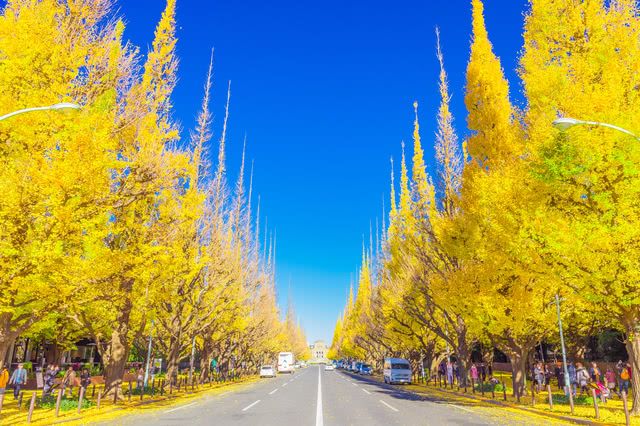
One of the most popular gingko-viewing locations in Tokyo is the rows of dazzling yellow trees adorning the streets of Meiji Jingu Gaien. If you get off at the Tokyo Metro's Gaienmae or Aoyama-itchome Stations and walk along Aoyama-dori Avenue, you will soon encounter a street leading to the Meiji Memorial Picture Gallery. This 300-meter boulevard is lined with magnificent ginkgo trees on both sides, with 146 trees spaced approximately 9 meters apart, all in procession toward the Picture Gallery in a splendid display. This remarkable landscape was actually developed through meticulous planning.
This street has a gentle 1-meter decline leading towards the Picture Gallery. The head landscape architect was Yoshinobu Orishimo, considered a master of modern landscape architecture in Japan. He calculated the height of the trees and the slope of the boulevard and incorporated the principles of perspective into the placement of the trees. It may be thanks to his profound knowledge of the art of painting that he came up with the idea to use perspective when designing the tree-lined street.

Every year, from mid-November to early December, the Ginkgo Festival is held in Meiji Jingu Gaien in line with the peak period for the golden leaves. The festivities are further enriched by an array of food stalls that offer palate-pleasing menus and special delicacies. The average temperature in Tokyo around late November is 14℃—comfortably cool and great for taking strolls. A leisurely walk beneath the golden canopies would be the perfect way to spend an afternoon.
Another annual event to look forward to is the illuminations that transform the streets into a luminous wonderland. From late November to early December, from 4:30 pm to 7:30 pm, the ginkgo trees come alive in golden radiance under the glow of the lights, offering an enchanting sight!
Delightful Dining Destinations to Enjoy on Your Strolls
Yakiniku USHIGORO Omotesando Branch (Omotesando / Japanese BBQ)

Don't miss the uniquely crafted dishes served exclusively at the Omotesando Branch, such as the [Tenderloin Sandwich -Rossini Style-] (3,200 JPY), a culinary delight where the final finishes are prepared at the table for guests to witness.
If you are celebrating a special occasion, opt for the [Bouquet de carpaccio] (2,100 JPY). The salad is arranged like a bouquet, with the Japanese beef carpaccio presented as flowers. The dish is served with Caesar dressing made with an abundance of cheese.

Yakiniku USHIGORO Omotesando branch
Closed: None
Average price: [Dinner] 10,000 JPY
Access: 5-minute walk from the B2 Exit of Omotesando Station
Address: 2F, Urban Terrace Aoyama, 5-50-3, Jingumae, Shibuya-ku, Tokyo Map
More Details Reservation
IL LUPINO PRIME TOKYO (Omotesando / Italian)

The signature menu item is the extravagant Italian steak dish, the [Bistecca alla Fiorentina], made with the finest USDA prime beef. Both sirloin and filet cuts can be savored with the [USDA Prime T-Bone Steak 800g] (26,400 JPY).
Another popular menu item is the [Handmade Pappardelle Truffle Cream Sauce] (3,960 JPY). The handmade, wide-noodle pasta boasts a chewy al dente texture and harmonizes perfectly with the creamy truffle sauce.

IL LUPINO PRIME TOKYO
Closed: None
Average price: [Dinner] 15,000 JPY / [Lunch] 5,000 JPY
Access: 5 minutes walk from the A3 exit of Omotesando Station on the Tokyo Metro Lines, and 7 minutes walk from the Exit 3 of Gaienmae Station on the Tokyo Metro Ginza Line. On the 2nd floor of Nonoaoyama
Address: 2F, Nonoaoyama, 3-4-3, Kita-Aoyama, Minato-ku, Tokyo
Disclaimer: All information is accurate at time of publication.
Thank you for reading our article.
Our goal is to take your culinary journey to the next level by helping you find the best restaurant. With SAVOR JAPAN, you can search and make reservations for
the Italian and Yakiniku restaurants found in and around Tokyo that fill your needs.
Discover more Italian and Yakiniku restaurants by area
- Tokyo Area
- Near Tokyo
- Kyoto and Osaka Area
- Hokkaido Area
- Northern Honshu (Tohoku)
- Central Honshu (Chubu)
- Western Honshu (Chugoku)
- Shikoku
- Kyushu
- Okinawa and Ryukyu Islands
Discover more restaurants to eat Italian/French Cuisine and Yakiniku/Steak by area
Related Articles
New Articles
Categories
Cuisine
- Bars (23)
-
Japanese Cuisine (676)
- Kaiseki (46)
- Nabe (19)
- Okonomiyaki (23)
- Shabu Shabu (37)
- Soba (18)
- Sushi (137)
- Tempura (19)
- Teppanyaki (46)
- Shojin Ryori (3)
- Tonkatsu (11)
- Kushiyaki (10)
- Yakitori (44)
- Sukiyaki (35)
- Japanese Cuisine (342)
- Oyster (2)
- Sashimi/ Seafood (20)
- Unagi (eel) (31)
- Motsu Nabe (offal hotpot) (6)
- Mizutaki (chicken hot pot) (3)
- Oden (8)
- Kaisendon (seafood bowl) (9)
- Udon (2)
- Taverns(Izakaya) Cuisine (123)
- Western Cuisine (42)
- Italian/French Cuisine (95)
- Yakiniku/Steak (224)
- Chinese Cuisine (26)
- Ramen (Noodles) Cuisine (25)
- Cafe/Sweets (60)
- Other Asian Cuisine (5)
- Global/International Cuisine (7)
- Alcohol (45)
- Other (11)
Area
- Shikoku (10)
- Kyoto and Osaka (344)
-
Tokyo (458)
- Tokyo (284)
- Ginza (43)
- Roppongi (22)
- Shibuya (26)
- Shinjuku (46)
- Asakusa (20)
- Ebisu (12)
- Tsukiji (10)
- Tokyo Landmarks (4)
- Ueno (23)
- Akihabara (9)
- Ikebukuro (12)
- Jiyugaoka, Denenchofu, Nakameguro (9)
- Shimokitazawa (4)
- Kichijoji (3)
- Tachikawa (1)
- Omotesando, Harajuku, Aoyama (18)
- Akabane (1)
- Kagurazaka (4)
- Akasaka (10)
- Odaiba (1)
- Tsukishima, Harumi, Toyosu (3)
- Near Tokyo (100)
- Okinawa and Ryukyu Islands (58)
- Hokkaido (124)
- Northern Honshu (Tohoku) (31)
- Central Honshu (Chubu) (144)
- Western Honshu (Chugoku) (32)
- Kyushu (92)
Archives
- December 2025(8)
- November 2025(4)
- October 2025(3)
- September 2025(6)
- August 2025(11)
- July 2025(19)
- June 2025(18)
- May 2025(34)
- April 2025(43)
- March 2025(30)
- February 2025(36)
- January 2025(26)
- December 2024(69)
- November 2024(31)
- October 2024(15)
- September 2024(39)
- August 2024(65)
- July 2024(31)
- June 2024(54)
- May 2024(61)
- April 2024(28)
- March 2024(31)
- February 2024(42)
- January 2024(32)
- December 2023(20)
- November 2023(5)
- October 2023(11)
- September 2023(7)
- August 2023(18)
- July 2023(8)
- June 2023(8)
- May 2023(18)
- April 2023(15)
- March 2023(1)
- January 2023(1)
- April 2022(2)
- March 2022(2)
- February 2022(1)
- January 2022(1)
- July 2021(1)
- March 2021(1)
- February 2021(1)
- December 2020(1)
- October 2020(1)
- September 2020(2)
- August 2020(10)
- July 2020(6)
- June 2020(9)
- May 2020(11)
- April 2020(8)
- March 2020(8)
- February 2020(13)
- January 2020(9)
- December 2019(24)
- November 2019(8)
- August 2019(14)
- July 2019(15)
- June 2019(18)
- May 2019(17)
- April 2019(16)
- March 2019(22)
- February 2019(22)
- January 2019(26)
- December 2018(34)
- November 2018(40)
- October 2018(32)
- September 2018(11)
- August 2018(8)
- July 2018(6)
- June 2018(9)
- May 2018(10)
- April 2018(21)
- March 2018(74)
- February 2018(39)
- January 2018(26)
- December 2017(59)
Keywords
- Omakase
- Accessible
- Affordable
- All-You-Can-Eat
- Amazing Scenery
- anime
- Art
- Autumn
- Awards
- Beer Gardens
- Breakfast
- Chef Recommendations
- Cherry Blossoms
- Chinese
- Close To Station
- Condiments
- Counter
- Coupon
- Crab
- Culture
- Dassai
- Dates
- delivery
- Early Summer
- Editor's Recommendation
- English Available
- Event
- Expo
- Fall Leaves
- Family-Friendly
- Famous Restaurant
- Famous Tourist Spot
- Fast Food
- festival
- fireworks
- Flower Farm
- Free Wi-Fi
- French
- Great Location
- Guide
- Hibachi
- hotpot
- How To
- hydrangea
- Hygiene
- Illumination
- Italian
- Izakaya
- Japanese
- Japanese alcohol
- jingisukan
- Kaiseki
- Kappo
- Kushiage
- Kushikatsu
- Kyoto
- Late-Night
- Lunch
- Manners
- matsusakagyu
- Michelin
- mizutaki
- Model Course
- monjayaki
- motsunabe
- Mt.Fuji
- Multilingual Menus
- Nabe
- Narita Airport
- New Year
- Ninja
- Noodle
- Oden
- Okonomiyaki
- omotenashi
- Onsen
- Osaka
- Osaka Station
- Photogenic Site
- pizza
- PR
- Private Room
- Ramen
- ranking
- Recipe
- Regional Cuisine
- Resort
- Rice Bowl Dish (Donburi)
- sacred places
- Sake
- Sakura
- Sashimi
- sea urchin
- Setouchi Area
- Shabu Shabu
- sightseeing
- Signature Dish
- Soba
- Solo Diners Welcomed
- Spicy Food
- Spring
- Steak
- Summer
- Sunflower
- Sushi
- takeout
- Teppanyaki
- Terrace Seating
- Tokyo
- Tokyo Experiences
- Tokyo Skytree
- Tokyo Tower
- unagi
- UNESCO
- Vegan
- Vegetarian
- Wagyu
- What Popular Gourmet Sites Recommend
- Whisky
- Wine Bar
- Winter
- Wisteria
- Workshop
- World Heritage Site
- World Writers
- Yakiniku
- Yoshoku
- Yuba
- Zen
Discover Restaurants By Area
-

Tokyo Area
Japan's largest city, Tokyo, is the center of culinary culture in Japan. Countless Tokyo restaurants serve every kind of food imaginable and the Toyosu fish market keeps restaurants stocked with the nation's finest fish.
-

Near Tokyo
Coastal areas, mountains and valleys surrounding Tokyo are bursting with tourist destinations, such as hot springs and ski slopes, where many unique foods are only available locally.
-

Kyoto and Osaka Area
The cities of Kyoto and Osaka, together with their surrounding areas, have greatly influenced Japan's culinary culture since the 7th Century. The region is renowned for its entertainment, Kobe beef, and wide-ranging traditional dishes.
-

Hokkaido Area
The island of Hokkaido is home to wide-ranging produce of the finest quality, such as rice, meat, vegetables, fish and fruit. Popular dishes from Hokkaido include robatayaki (food slowly roasted on skewers) and Sapporo miso ramen.
-

Northern Honshu (Tohoku)
The northern end of Japan's main island, Honshu, is renowned for its seasonal fruit and vegetables, nation-leading harvest of fish (especially tuna from Ohma), and delicious beef from Yonezawa, Sendai and Yamagata.
-

Central Honshu (Chubu)
Chubu is in the center of Japan's main island, Honshu, and its culinary culture reflects its position between Japan's western and eastern halves. Delicious Hida beef, world-famous Mount Fuji and many acclaimed sake breweries are in Chubu.
-

Western Honshu (Chugoku)
Chugoku, on the southwest of Japan's main island, is rich with diverse produce. Many of its products are praised as Japan's best, including Matsuba crabs from Tottori and oysters from Hiroshima. Its pears and muscats are also top grade.
-

Shikoku
The mild climate of Shikoku is ideal for growing citrus fruit such as sudachi. Shikoku is also famous for Sanuki udon noodles, huge yields of tiger prawn from Ehime Prefecture and the best torafugu (tiger globefish) in the country.
-

Kyushu
Western culture was first introduced to Japan through Kyushu, Japan's third largest island, where the influence of Portuguese and other western cuisine influenced the creation of a colorful culinary tradition.
-

Okinawa and Ryukyu Islands
Okinawa, Japan’s southernmost prefecture, is a treasure trove of distinctive dishes and drinks that have become popular throughout Japan, including Okinawa soba, unique sushi toppings and Awamori distilled liquor.
